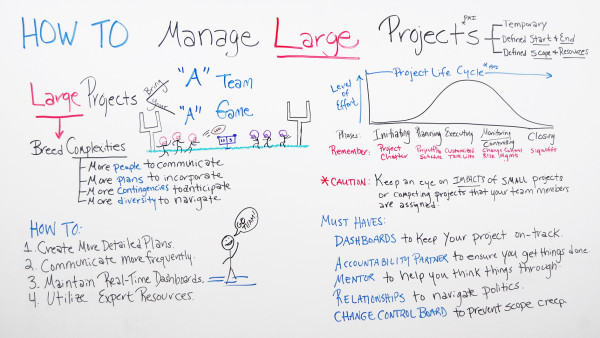In this video, Jennifer Bridges, project management expert, discusses the complexities in managing large projects and tips for getting the support and resources you need to succeed.
Here’s a shot of the whiteboard for your reference!

In Review: How to Manage Large Projects
Managing large projects, as Jennifer notes, can be overwhelming, particularly if you don’t have extensive experience or aren’t a credentialed project manager. She offered some tips on how to better accomplish what might feel like an impossibility. Naturally, you’ll want to assemble the best team possible to take on this large job. It’s going to get complex, with more people to communicate with, more plans to incorporate and more contingencies to navigate, so you’ll definitely need to gather support from your sponsor or a mentor. There can be a lot of politics on large projects, so it’s important to get as much stakeholder support as you can muster, and set up processes for managing change as requests arise. Follow these four steps to deal with the issues of working on big projects:
- Make your plans more detailed
- Frequently communicate
- Real-time dashboard views to monitor progress
- Use expert resources
As Jennifer said, you’ll need a project charter to identify exactly the vision, goals and deliverables of the project you’re engaged with. Then you want to make sure you have the proper and authorized sign-offs and not neglect the smaller sub-tasks that make up the larger whole.
Pro-Tip: There are must-haves for any project, and that’s also true of big ones. They are the accountability from partners; a mentor to bounce off ideas and help with problems encountered along the lifecycle of your project; and cultivating relationships inside and outside your organization to help you get things done on time. Thanks for watching!
Transcription
Well, today we’re talking about how to manage large projects and, although we can’t cover everything, here are a few tips.
First of all, when you’re managing large projects, be sure to bring your A-Team and your A-Game, because just due to the nature of large projects, they breed complexity. There are more people to communicate with. There are more plans to incorporate. There are more contingencies to anticipate and more diversity and navigation. So how do we do this?
Number one, we create more detailed plans, making sure everybody has the level of detail that they need to get their work done. And communicate more frequently. Not only more frequently but differently depending upon what level you’re communicating with.
Number three is maintaining real-time dashboards. By using real-time dashboards, you have the information available to you to make quick decisions. And also utilize expert resources. This is, for sure, a time that you want to make sure you have the experts and it’s a time that you want to fight for those and make sure they stay on your team.
When we consider the project life cycle, there are just a few things that I want to highlight that you want to make sure that you have in your plan for each of the phases. In initiating, you want to make sure you have your Project Charter. Whether you call it a project charter or not, you’re going to have some Statement of Work (SOW) or some document that identifies what this project is.
Also, in planning, you want to make sure you have your project plan with your detailed processes and your schedule. Then in executing you want to have customized task lists so the people doing the physical work and the activities only are looking at what they have to complete. And in monitoring and controlling, really leveraging your change control and your risk management processes.
And last but not least, in the closing is making sure that you have the proper and authorized sign-offs. And a caution here is to keep an eye on the impacts of small or competing projects that your team members may be working on. And then here are my must-haves.
When you’re working on a large project you want to make sure you have your dashboards to make sure that you can keep your project on track. Also by having an accountability partner, somebody you can work with to make sure you, as the project manager, are getting things done.
Also, a mentor can help you think through things. They have already been there, done that. They probably know the organization, some of the members, and the type of projects you’re working on. So they’re a great sounding board.
And then also ensuring you have the relationships inside and outside your organization. They just help you navigate politics better and get things done. And then your change control board sure can take a lot of the pressure off and they can help you prevent scope creep on your project.
So if you need a tool that can help you manage your large projects, then sign up for our software now at ProjectManager.

